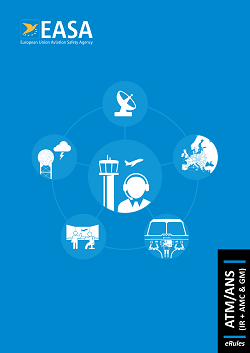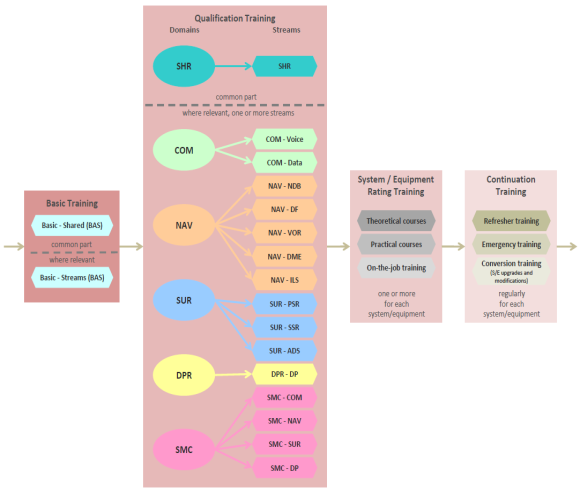ATSEP.OR.200 Training requirements — General
Regulation (EU) 2017/373
A service provider shall ensure that ATSEP:
(a) have successfully completed:
(1) the basic training as set out in point ATSEP.OR.205;
(2) the qualification training as set out in point ATSEP.OR.210;
(3) the system/equipment rating training as set out in point ATSEP.OR.215;
(b) have completed continuation training in accordance with point ATSEP.OR.220.
GM1 ATSEP.OR.200 Training requirements — General
ED Decision 2020/020/R
GM2 ATSEP.OR.200 Training requirements — General
ED Decision 2017/001/R
STRUCTURE SYLLABI
Guidance material on how to read the tables in the appendices contained in this Subpart A of ANNEX XIII is provided in Appendix 5a.
GM1 ATSEP.OR.200(a) Training requirements — General
ED Decision 2017/001/R
For the purpose of this section, ‘basic training’ is understood as being training designed to impart fundamental knowledge of the service provider’s operational environment.
For the purpose of this section, ‘qualification training’ is understood as being training designed to impart knowledge and skills appropriate to the qualification stream to be pursued in the service provider’s operational environment.
SYSTEM/EQUIPMENT RATING TRAINING
For the purpose of this section, ‘system/equipment rating training’ is understood as being training designed to impart system/equipment-related knowledge and skills leading towards operational competence.
For the purpose of this section, ‘continuation training’ is understood as being training designed to maintain and/or augment existing knowledge and skills related to the ATSEP assigned responsibilities and duties.
Regulation (EU) 2017/373
(a) The basic training of ATSEPs shall comprise:
(1) the subjects, topics, and sub-topics contained in Appendix 1 (Basic training — Shared);
(2) where relevant to service provider's activities, the subjects contained in Appendix 2 (Basic training — Streams).
(b) A service provider may determine the most suitable educational requirements for its candidate ATSEP and, consequently, adapt the number and/or level of subjects, topics or sub-topics referred to in point (a) where relevant.
GM1 ATSEP.OR.205 Basic training
ED Decision 2017/001/R
The basic training contained within the requirement is the minimum training that needs to be followed by all who aim at becoming ATSEP. However, service providers may decide to add additional subjects or topics that may be specific to their national or local environment.
Basic training may be provided as a stand-alone course or as part of a larger initial training course (i.e. basic plus qualification training).
AMC1 ATSEP.OR.205(a) Basic training
ED Decision 2020/020/R
The selection of the subjects, topics, and subtopics should be tailored to:
(a) the duties of the ATSEP regarding the service provider’s activities; and
(b) prior experience and education of the candidate ATSEP.
AMC1 ATSEP.OR.205(a)(1) Basic training
ED Decision 2017/001/R
The objectives contained in Appendix 1a to this AMC should be included in the basic training course.
AMC1 ATSEP.OR.205(a)(2) Basic training
ED Decision 2017/001/R
The topics, sub-topics and objectives contained in Appendix 2a to this AMC should be included in the basic training course.
GM1 ATSEP.OR.205(b) Basic training
ED Decision 2020/020/R
ENTRY LEVEL
In some instances, only a limited number of training objectives will need to be taught to ATSEP learners. This is usually the case when the entry level of learners includes some form of previous qualification (e.g. engineering degree or diploma). In this case, the length of training and the number of objectives may be less than that of a course directed to learners who have little or no engineering or technical qualifications. If no engineering or technical qualifications are required prior to starting the basic training, then it may be necessary to include additional objectives in the training that will prepare learners to deal with the basic training.
ATSEP.OR.210 Qualification training
Regulation (EU) 2017/373
The qualification training of ATSEPs shall comprise:
(a) the subjects, topics, and sub-topics contained in Appendix 3 (Qualification training — Shared);
(b) where relevant to its activities, at least one of the qualification streams, contained in Appendix 4 (Qualification training — Streams).
AMC1 ATSEP.OR.210 Qualification training
ED Decision 2020/020/R
The selection of the subjects, topics, and subtopics should be tailored to:
(a) the duties of the ATSEP regarding the service provider’s activities; and
(b) prior experience and education of the candidate ATSEP.
AMC2 ATSEP.OR.210 Qualification training
ED Decision 2017/001/R
The objectives contained in Appendix 3a to this AMC should be included in the qualification training course.
GM1 ATSEP.OR.210 Qualification training
ED Decision 2017/001/R
MINIMUM TRAINING
The qualification training contained within the requirement is the minimum training that needs to be followed by all who aim at becoming ATSEP. However, service providers may decide to add additional subjects or topics that may be specific to their national or local environment.
COMPOSITION OF COURSES
Qualification training may be provided as (a) stand-alone course(s) or as part of a larger course.
AMC1 ATSEP.OR.210(a) Qualification training
ED Decision 2017/001/R
The objectives contained in Appendix 4a to this AMC should be included in the qualification training course.
GM1 ATSEP.OR.210(b) Qualification training
ED Decision 2017/001/R
For the purpose of this section, ‘streams’ is understood as being a cluster of training objectives that support a particular area of work.
ATSEP.OR.215 System and equipment rating training
Regulation (EU) 2017/373
(a) The system and equipment rating training of ATSEPs shall be applicable to the duties to be performed and include one or several of the following:
(1) theoretical courses;
(2) practical courses;
(3) on-the-job training.
(b) The system and equipment rating training shall ensure that candidate ATSEP acquire knowledge and skills pertaining to:
(1) the functionality of the system and equipment;
(2) the actual and potential impact of ATSEP actions on the system and equipment;
(3) the impact of the system and equipment on the operational environment.
GM1 ATSEP.OR.215 System and equipment rating training
ED Decision 2017/001/R
A system and equipment rating is the authorisation which allows the ATSEP to perform operational tasks on specific system/equipment and may, optionally, include an association with operational site/s, location/s and/or maintenance task levels. The award of this rating follows the successful assessment of operational competence.
The term ‘rating’ in the definition of ‘system/equipment rating training’ should not be associated with the definition of ‘rating’ in Regulation (EC) No 216/2008.
ATSEP.OR.220 Continuation training
Regulation (EU) 2017/373
The continuation training of ATSEPs shall comprise refresher, equipment/systems upgrades and modifications, and/or emergency training.
AMC1 ATSEP.OR.220 Continuation training
ED Decision 2017/001/R
The frequency and duration of continuation training should be determined by taking into account the ATSEP task exposure (recency) as well as the complexity of the operation and of the maintenance of systems.
GM1 ATSEP.OR.220 Continuation training
ED Decision 2017/001/R
(a) For the purpose of this section, ‘refresher training’ is understood as being training designed to review, reinforce or upgrade existing knowledge and skills (including team skills).
(b) Refresher training may periodically include training to refresh and augment ATSEP team skills. Team skills include but are not limited to communication, negotiation, decision-making, conflict resolution and listening skills.
(c) ‘Emergency training’ is understood as being training designed to broaden knowledge, skills, and behaviour in case of emergency, unusual or degraded situation. Most of the training will be site-specific or may make use of incident or accident analysis.
(d) The term ‘emergency’ is considered as a serious, unexpected and/or potentially dangerous situation requiring immediate action(s), e.g. complete loss of any of the following:
— radar display picture;
— Electronic Flight Progress Strip system;
— main, standby and emergency communications on multiple frequencies due to external interference blocking the radiotelephony channels.
(e) The term ‘unusual situation’ is considered as a set of circumstances which are neither habitually nor commonly experienced and for which an ATSEP has not developed a practised response.
(f) The term ‘degraded situation’ is considered as a situation that is the result of a technical system failure or malfunction or a set of circumstances arising from human error or violation of rules affecting the quality of the service provided (i.e. the service continues to be available, even though in a reduced or limited way). For instance, external main supply’s failure to a Category III ILS localiser field site cabin or a normally dual channel DME having a fault on one channel.

